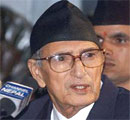
Nepal is gearing to leap in new era where democracy prevails; the people who are dreaming big gathered from dawn to cast their vote to change the long worn attire of their country, monarchy.
The people of Nepal will vote for 601-member constituent assembly that will draft a new constitution, which will help Nepal to reorganise and rationalise.
The road to end 240-year old monarchy has become the cynosure of all eyes, with hundreds of international observers and monitors across the world.
Though the violence in pre-election campaign has taken more than ten lives, people with their hand on thumping heart have waited this day to come.
Current implication
Today, the country has reached to the day when the democratic process has begun, the election after nine years of gap and two years after King Gyanendra decided to climb down has pulled all the attraction.
The election result will decide the response in Nepal; first if the parties in coalition win; King has to give them way towards reliance of the cherished goal of Nepal becoming a federal democratic state.
Second, if the other contender Communist Party of Nepal (Maoist) does not win the election.
But here if first one happens, will it be possible for the government to run it peacefully or if the second one happens will it still be possible to run the government. As recently it was reported that Young Communist League leaders threatened and attacked voters and rival party’s member respectively.
Is it possible that there will be no rigging in the vote? Do involvement of UN and other international communities will help in engineering the achievement?
Even though if any party gets the majority, how will it sort the differences assorted during drafting the new constitution, when there are Madhesis on one hand and Nepalese on other.
The days to come will spell the future of Nepal.
History
Since Communist Party of Nepal (Maoist) led the campaign to oust monarchy in 1996, the turf between government forces and Maoists guerillas killed 12,000 people. Whereas in June 2001 major blow came to Royal family after the massacre of King, Queen and Prince Dipendra. The prince was accused of killing the royal family members, who later committed suicide. But the murder remains enshrouded there in mystery and people’s conviction denied accepting the theory.
King Gyanendra becomes the reigning king and soon after he came to power he sacked the government and started quashing the violent protest by Maoist. In the last quarter of 2005 the Maoist declared three-month unilateral ceasefire to negotiate their demands.
The Seven Party Alliance (SPA) of parliamentary parties and the Communist Party of Nepal (Maoist) agreed on a historic and unprecedented 12-point memorandum of understanding (MOU) for peace and democracy. Nepalese from various walks of life and the international community regarded the MOU as an appropriate political response to the crisis that was developing in Nepal. The SPA and Maoist called for protest, which led to massive uprising.
The later developments were of more importance; the King reinstated the sacked government giving them more power. The same government then spelled doomsday for king and unanimously passed the decision to restrain monarchy.
But soon the hope arrived when initiative was taken to end civil war and in 2006 the Interim Parliament of Nepal declared Nepal as a secular state while in 2007 it was again declared as federal democratic republic.
Also in 2006 the then Prime Minister Girija Prasad Koirala wrote UN on its preparedness to go for the election in 2007, which again came under cloud due to Maoists unrealistic demands.
Political Parties
The Nepali Congress is a moderate socialist party, which has recently nodded for transferring constitutional monarchy to republic form of government for Nepal. The once splinter group Nepali Congress (Democratic) has united with it. The Communist Party of Nepal later split into two sections: the moderate formed the Communist Party of Nepal (Unified Marxist-Leninist) and the radical, formed the Communist Party of Nepal (Unity Centre). CPN (UC) was again divided to form Communist Party of Nepal (Maoist), while the royalist includes of Rashtriya Prajatantra Party which has its small divided arm called Rashtriya Janashakti Party.
|
|
Read More: Maoist


Comments:
NIMESH UPADHAYA
May 10, 2008 at 12:00 AM
NEPAL WILL NEVER BE A PEACEFUL COUNTRY AGAIN AS IT WAS PREVIOUSLY.VOTING WITHOUT ID CARD WAS THE BIGGEST TOOL FOR THE MAOIST TO WIN THE ELECTION. INTERNATIONAL OBSERVERS WERE ENJOYING IN 5 STAR HOTELS IN KATHMANDU AND MAOIST WERE ENJOYING CAPTURING BOOTHS PEACEFULLY. ITS VERY DIFFICULT TO SEE NEPAL AS A MAOIST COUNTRY.